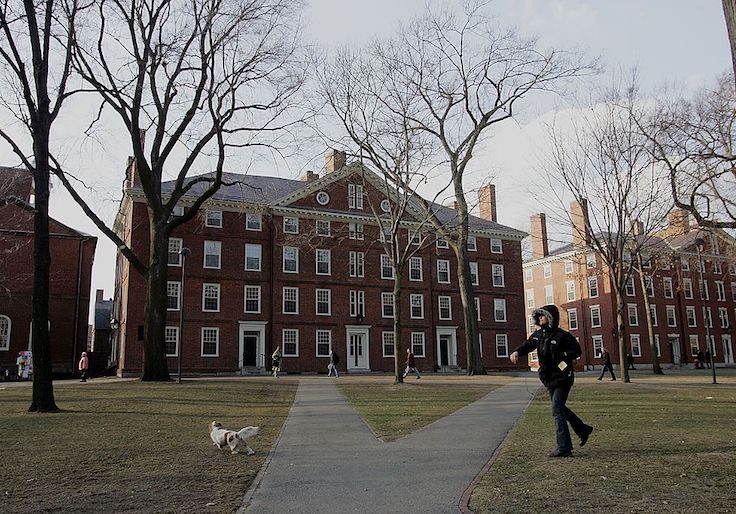Harvard systematically advertised to black students whose low standardized test scores gave them little chance of being admitted, a new study reveals, in what the authors suggest was a bid to obscure racial quotas at the university.
The paper, based on data made public by the ongoing discrimination lawsuit against Harvard, shows that starting in 2004 the university saw a substantial increase in the number of applications from low-scoring students, in particular African Americans. The study's authors—one of whom, Peter Arcidiacono, served as an expert witness for the lawsuit's plaintiff—argue that this increase was at least in part a deliberate policy choice by Harvard's admissions office to disguise affirmative action.
If true, this finding provides yet more ammunition for critics of Harvard, which continues to face charges of anti-Asian discrimination. At the same time, the study casts a less-than-flattering light on the racial dynamics at play in admissions to one of America's most elite universities.
As Arcidiacono and his coauthors have previously shown, admission rates have dropped precipitously since the turn of the millennium. "With such low admit rates, many applicants simply have no chance of being admitted, suggesting clear information problems in this market," the study says. Why, then, do people keep applying in droves?
The story is even odder when it comes to black applicants. Harvard assigns each applicant an "academic index," a score between 60 and 240 that synthesizes SATs, SAT IIs, and self-reported GPA. Among black applicants who are not athletes, legacy, dean's interest list, or children of faculty/staff, 40 percent are in the bottom tenth of academic indexes among all applicants; 60 percent are in the bottom fifth. By comparison, only 13 percent of whites and 9 percent of Asians are in the bottom fifth.
Being in the bottom decile means that you have "essentially no chance of being admitted to Harvard." Of the 5,900 black applicants in that group between 2014 and 2019, just 2 (0.03 percent) were admitted.
"Why are there so many African American applicants to Harvard who appear to effectively have no chance of being admitted?" the study's authors ask. "Harvard's recruitment strategy appears to play a role."
Like many universities, Harvard buys information about students—test scores, GPAs, etc.—from the College Board, and uses it to target potential applicants with advertising. To determine who does and does not merit contact, Harvard has test-score and GPA thresholds that vary based on race and sex, according to the paper. To receive mail from Harvard, a White or Asian boy needs an SAT above 1380, while a White or Asian girl needs to be over 1350. But among certain minorities—black, Hispanic, and Native American kids—the cutoff is just 1100.
That threshold is about 330 points lower than the average SAT score of minority kids who actually get admitted. The paper shows that these cutoffs, converted into academic index scores, map directly to the bottom deciles mentioned above.
"In other words," the authors write, "Harvard is actively sending recruiting materials to prospective students who effectively have no chance of being admitted."
Things were not always this way. While Harvard applications have been growing steadily since 2000, the number of African American applicants only took off in 2004. This bump was driven by low-scoring applicants: "Between [the class of] 2009 and 2013, the number of African American applicants with SAT math scores below 550 increased from approximately 300 to nearly 800," the paper says. "In [the class of] 2012 alone, there were more African American applicants with scores below 550 than with scores above 640. These patterns are not mirrored by other racial groups."
The authors point to two possible explanations for this timing: Harvard substantially expanding financial aid in 2004, and the Supreme Court's 2003 Grutter v. Bollinger decision, which permitted affirmative action in higher education while explicitly rejecting "racial quotas." The ruling raised what the authors call "liability concerns related to affirmative action." These "concerns" are particularly relevant to understanding the sudden uptick.
Prior to 2003 and Grutter, African American applicants were substantially more likely to be admitted to Harvard than their non-black peers with similar SAT scores. Fearing that the higher admission rates may look like unconstitutional discrimination, Harvard artificially inflated the pool of black applicants while keeping the number of black admits constant, the authors suggest.
This in turn meant that admission rates among black applicants fell, which "resulted in substantial convergence in the overall admissions rates across races."
In fact, the authors find that the racial disparities persist among high achievers. Among students who scored above a 740 on SAT math, "African Americans were 4.46 times more likely to be admitted than Asian Americans in 2009 and 4.65 times as likely in 2016." In other words, high-scoring black students still have much better chances of attaining admission—there are just fewer of them as a share of total applicants.
The result is that Harvard maintains a diverse class without admitting significantly more black applicants than white applicants. The only losers are the thousands of African American teenagers who, every year, receive a letter from Harvard inviting them to apply, even though they have no hopes of admission.
